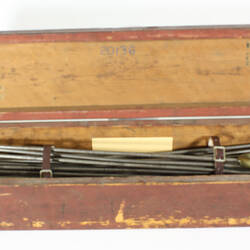Summary
Metal Gunter's type surveyor's chain used to measure land distances. A 'chain' is a unit of length as used by surveryors where 100 links = 22 yards = 66 feet = 1/80th of 1 mile.
The first surveyor's chain was designed by the English clergyman and mathematician Edmund Gunter (1581-1626) and introduced in 1620. It comprised of a metal chain made up of 100 links measuring a precise overall length of 66 ft or 22 yards - with each link thus measuring 7.92 inches (201.168 mm). The Gunter's chain was originally intended to be used in the accurate laying out and measurement of plots of land, for legal and commercial purposes, but was subsequently widely used by surveyors throughout the British Empire and Europe, with an Imperial mile being 80 times the Gunter's chain length. The similar, but more accurate Ramsden's chain, was developed by the British scientific insrument maker and optician, Jesse Ramsden (1735-1800), for the Anglo-French Survey (1784-1790), Britain's first high-precision geodetic base-line survey and was later used for similar geodetic surveys throughout the British Empire. The original Ramsden chain had 100 links of precisely 1 foot each in length, measuring 100 feet (30.480 m) in overall length.
Physical Description
Brass hand grips at each end of chain. Wire links are apprxomiately eight inches long. Incised tags or markers are attached to each tenth link of chain to assist with the more accurate recording of intermediate distances.
More Information
-
Collecting Areas
-
Acquisition Information
Donation from Surveying Department, University of Melbourne (The), 31 Jul 1978
-
Date Used
-
Classification
-
Category
-
Discipline
-
Type of item
-
Overall Dimensions
17120 mm (Length), 94 mm (Width)
Measurement of chain extended to full length.
-
Keywords

